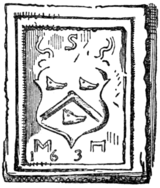supporters. His seal (Fig. 735) belongs to the second earliest of the Douglas charters preserved at Drumlanrig. Its date is 1389, and Sir John de Swintoun is described as Dominus de Mar, a title he bore by right of his marriage with Margaret, Countess of Douglas and Mar. This probably also accounts for his coronet, and it is interesting to note that the helmet, coronet, and crest are the exact counterpart of those on the Garter plate of Ralph, Lord Basset, in St. George's Chapel at Windsor. It is possibly more than a coincidence, for Froissart mentions them both as fighting in France ten to twenty years earlier.

Fig. 738.—Arms of Swinton. (From Swinton Church, 163-.)
Of his son, the second Sir John, "Lord of that Ilk," we have no seal. His lance it was that overthrew Thomas, Duke of Clarence, the brother of Henry V., at Beaugé in 1421, and he fell, a young man, three years later with the flower of the Scottish army at Verneuil; but in 1475 his son, a third Sir John, uses the identical crest and shield which his descendants carry to this day (Fig. 736). John had become a common name in the family, and the same or a similar seal did duty for the next three generations; but in 1598 we find the great-great-grandson, Robert Swinton of that Ilk, who represented Berwickshire in the first regularly constituted Parliament of Scotland, altering the character of the boars' heads (Fig. 737). He would also appear to have placed upon the chevron something which is difficult to decipher, but is probably the rose so borne by the Hepburns, his second wife having been a daughter of Sir Patrick Hepburn of Whitecastle.
Whatever the charge was, it disappeared from the shield (Fig. 738) erected on the outer wall of Swinton Church by his second son and eventual heir, Sir Alexander, also member for his native county; but




